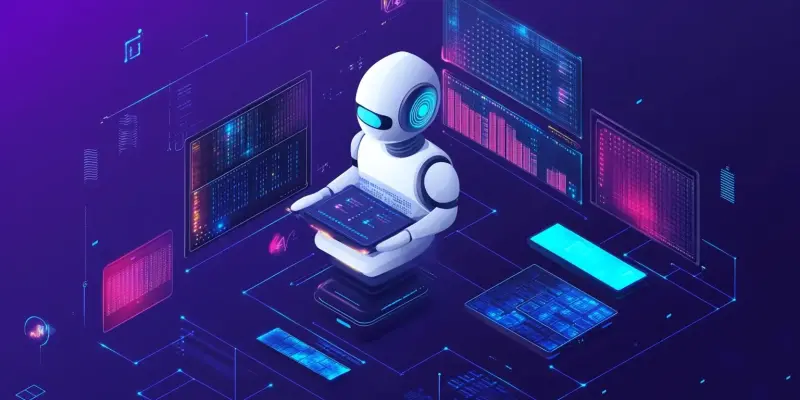The intricate relationship between artificial intelligence (AI) and data storage underscores a compelling technological evolution. As AI continues to generate massive quantities of data, the effective storage and management of this data become pivotal to its functionality. Concurrently, AI’s exponential demand propels advancements in storage technologies, resulting in a synergistic relationship where each domain drives the other forward. This dual dependency highlights a critical balance necessary to harness AI’s full potential, ensuring data storage solutions evolve to meet growing needs efficiently and sustainably.
The Symbiotic Relationship Between AI and Data Storage
AI’s ability to generate, analyze, and utilize vast amounts of data fundamentally hinges on the quality and accessibility of data storage infrastructures. This perpetual loop of data generation and consumption is crucial for refining AI models and enhancing their outputs. As AI systems become more sophisticated, the necessity for mass-capacity storage solutions increases exponentially to support these advancements fully. However, a significant challenge emerges in the disparity between the rapid growth of data and the relatively slower expansion of storage infrastructure, creating a bottleneck in technological progress.
According to Seagate’s analysis, which is based on IDC’s 2024 Global DataSphere research, data is projected to grow at a robust annual rate of 25% between 2024 and 2028. In contrast, the storage installed base is expected to grow at a slower compound annual growth rate (CAGR) of 17%. This discrepancy underscores the urgent need to bridge the gap to ensure businesses can leverage AI advancements effectively. Without addressing this imbalance, the data bottleneck could hinder AI’s full potential, stalling innovation and progress in various fields relying on AI-driven insights.
Addressing the Storage Demand Gap
To effectively bridge the gap between rapid data generation and slower storage infrastructure expansion, innovative solutions are paramount. One essential strategy is improving storage density, which refers to the amount of data that can be stored in a given physical space. Advances in areal density, for instance, have allowed hard drives to achieve over 3 terabytes (TB) of storage per platter. This milestone enhances not only the storage capacity but also the power efficiency and sustainability of data storage solutions, reducing the environmental impact per terabyte stored.
The increased storage density exemplifies a way to meet the escalating demands for AI data storage without necessitating excessive physical expansion. By maximizing the data capacity within existing physical constraints, businesses can effectively manage their growing data requirements. Moreover, this approach aligns with sustainability goals, as it contributes to reducing the carbon footprint and resource consumption associated with data storage technologies. It highlights the importance of balancing technological advancements with environmental considerations, ensuring a sustainable future for data storage solutions.
AI-Driven Enhancements in Storage Technologies
A prime example of leveraging AI to optimize storage design is Seagate’s collaboration with NVIDIA. By utilizing NVIDIA’s advanced technologies, Seagate aims to meet the growing storage demands of AI and accelerate the development of future generations of its Mozaic hard drives. This partnership focuses on streamlining various simulation workflow aspects, including model building, solution algorithms, post-processing, and visualization tasks. Integrating GPU-accelerated computing into these processes has enabled Seagate to significantly speed up its hard drive design lifecycle, improve time-to-market, and align with sustainability goals.
This AI-driven approach to storage technology development epitomizes how AI can enhance efficiency and innovation within the data storage industry. By harnessing the power of AI and GPU-accelerated computing, companies can reduce development times, create more robust and energy-efficient storage solutions, and swiftly bring these solutions to market. This synergy highlights the mutual benefits of integrating AI into storage design, ultimately advancing both fields’ capabilities and ensuring they remain competitive in an increasingly data-driven world.
Broader Implications and Benefits
AI-driven storage innovations extend beyond merely enhancing storage capacity and efficiency. Efficient product modeling and design optimization, facilitated by AI, enable companies to handle more complex models, reduce the need for physical prototyping, and lower energy consumption during the design process. These advancements benefit a wide range of stakeholders, fostering agility and competitiveness across various sectors. Customers, for instance, gain quicker access to advanced hard drive technologies, allowing them to optimize their operations and achieve faster returns on investment.
Additionally, AI-driven storage solutions enable partners within the technology ecosystem to collaborate more dynamically, reach markets more rapidly, and enhance resource efficiency. By streamlining development processes and improving product performance, these innovations contribute to a more efficient and sustainable technology landscape. The ripple effects of these advancements extend to end-users and businesses, driving overall productivity and technological progress. This broader impact underscores the significance of AI-driven innovations in shaping the future of data storage and its associated industries.
The Future of Data Storage in the AI Era
The complex connection between artificial intelligence (AI) and data storage underscores a fascinating technological progression. As AI relentlessly generates vast amounts of data, the efficient storage and management of this data become crucial to its effective operation. In turn, AI’s growing need for vast quantities of data significantly accelerates advancements in storage technologies. This interaction creates a symbiotic relationship where each field continually pushes the other forward. Such mutual reliance points to the need for a fine balance to fully exploit AI’s potential. It’s essential for data storage solutions to adapt and grow to meet these increasing demands efficiently and sustainably. The evolution of AI and data storage technologies isn’t just about keeping up; it’s about ensuring that each evolves to support the other. Balancing this relationship is key to harnessing the full capabilities of AI, making sure both data creation and data management work in harmony for optimal outcomes. This ongoing evolution highlights the importance of innovative data storage solutions that are both powerful and sustainable.

